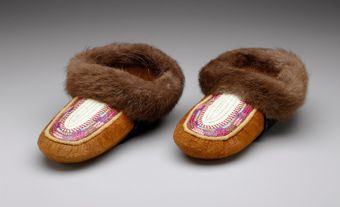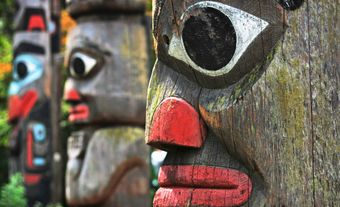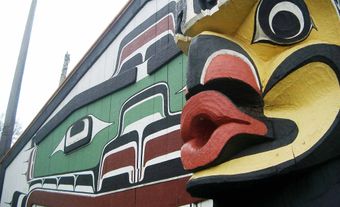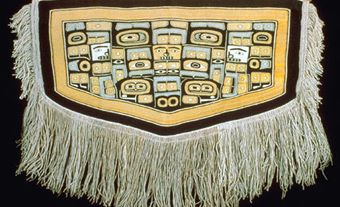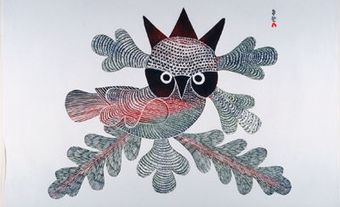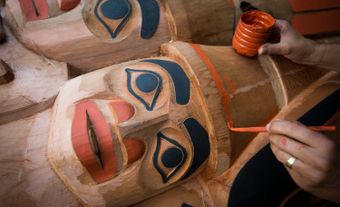Corrine Hunt, Kwakwaka'wakw/Tlingit artist (born in 1959 in Alert Bay, BC). Hunt is a respected artist who has created hand-crafted jewelry, accessories, art installations and furniture. In 2010, she co-designed the Vancouver Winter Olympic medals. Hunt is a strong and vocal supporter of the arts. In addition to her own work, she mentors other artists and strives to promote the traditional art of Northwest Coast Indigenous peoples. Her unique designs and art installations showcase her personal history as well as her cultural heritage.

Early Life
Corrine Hunt was born in Alert Bay on Cormorant Island near the northeastern tip of Vancouver Island, British Columbia, in 1959. She is of Komoyue and Tlingit heritage, and is a member of the Raven Gwa’wina clan from Ts’akis, a Komoyue village on Vancouver Island.
Hunt comes from a distinguished family, including Kwakwaka'wakw artists Henry, Tony, Richard and Stanley Hunt. Her paternal grandfather, Jonathan Hunt, was a Kwakwaka'wakw chief. Her paternal grandmother, A’neesla’ga’ (Abusa), was a Tlingit noblewoman from Alaska. A’neesla’ga’ gave Hunt the name “Killer Whale Scratching Her Back on the Beach” in 1965.
Since 1975, Hunt has lived in the Vancouver area. She attended Simon Fraser University in Vancouver, where she studied anthropology and Latin American studies.
Artistic Influences
In 1986, Hunt’s maternal uncle, Norman Brotchie, introduced her to the art of hand-carved jewelry and to Kwakwaka'wakw art history. Since then, Hunt has worked primarily as a jeweller, engraving accessories, such as rings, bracelets, pendants and broaches, that reflect the themes and traditions of her heritage.
Hunt also creates sculptural installations, including totem poles and custom furniture. She credits her relatives and fellow carvers, Henry, Tony and Richard Hunt as artistic inspirations.
Did You Know?
Using Northwest Coast Indigenous design elements, Corrine Hunt redesigned the logo of the professional Canadian football team, the BC Lions, for the Orange Shirt Day Game in 2021. The logo was printed on 10,000 t-shirts, given out to fans in support of National Day for Truth and Reconciliation. In 2022, the special logo was also found on the BC Lions helmets during the game held on 30 September.
Artwork
Since 1985, Hunt’s work has included engraved gold and silver jewelry and accessories, totem poles and furniture carved in stainless steel and reclaimed wood. She has also recently produced a collection of mukluks, with designs inspired by her family and cultural history.
In all of her artwork, Hunt seeks to incorporate her heritage and to bring the stories of her people to contemporary life. Her jewelry and accessories feature design characteristics common to the art of Northwest Coast Indigenous peoples, including depictions of animals, such as killer whales, wolves, eagles and hummingbirds.
Hunt’s work can also be seen as representative of the concept of living culture; she designs installations, such as furniture, that are practical, but infused with cultural significance. In her recent collection, Coco de Wolfe, Hunt created household items from reclaimed wood and steel that feature her interpretation of traditional Northwest Coast designs.
Throughout her career, Hunt has created more than 2,000 designs and art installations that have been displayed across British Columbia, including at the Hilton Hotel in Whistler and in the office of Indigenous and Northern Affairs Canada in Vancouver. In 2006, she designed the logo for the World Peace Forum held in Vancouver. In 2011, Hunt also designed a museum exhibition, The Great Potlatch: Gift Giving Customs and Economies of Plenty, for the Staatliche Kunstsammlungen Dresden Museum in Germany.
Olympic Medals
On 15 October 2009, the Vancouver Organizing Committee for the 2010 Winter Olympic and Paralympic Games announced that Hunt would co-create the Olympic medals with industrial designer and architect Omer Arbel.
Hunt created two large master artworks that became the blueprints for the medals; an orca whale as the motif for the Olympic medals and a raven as the motif for the Paralympic medals. All of the medals were hand-cropped, making each one unique. They were also all struck nine times as part of a 30-step fabrication process to create the distinctive, wave-like design. Each medallist received a silk scarf printed with the master artwork along with their medal.
Awards and Honours
In 2011, Hunt was awarded the National Aboriginal Achievement Award (now the Indspire Awards) for her outstanding career achievement and for serving as a role model to Indigenous youth.

 Share on Facebook
Share on Facebook Share on X
Share on X Share by Email
Share by Email Share on Google Classroom
Share on Google Classroom



